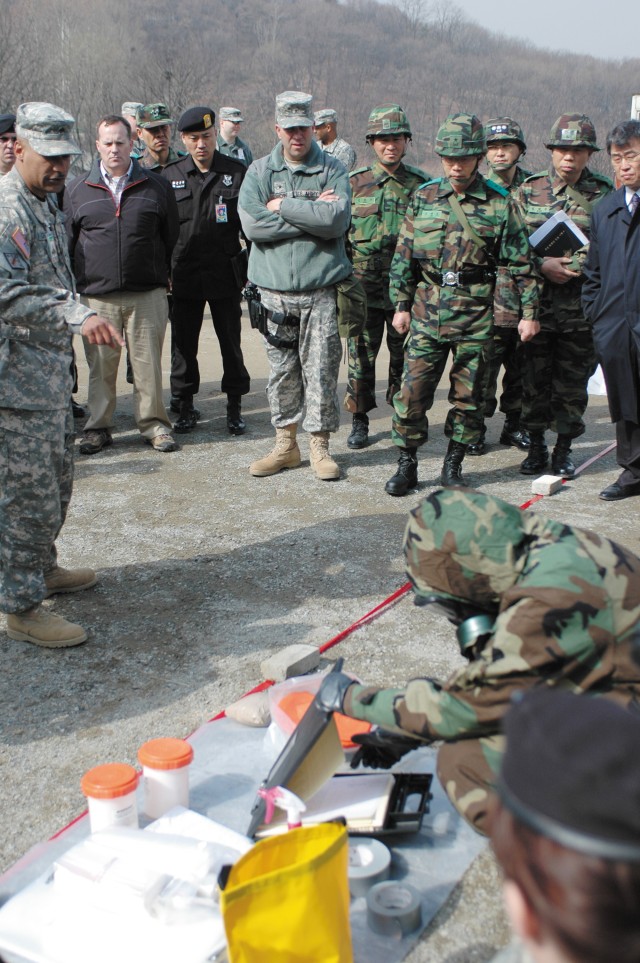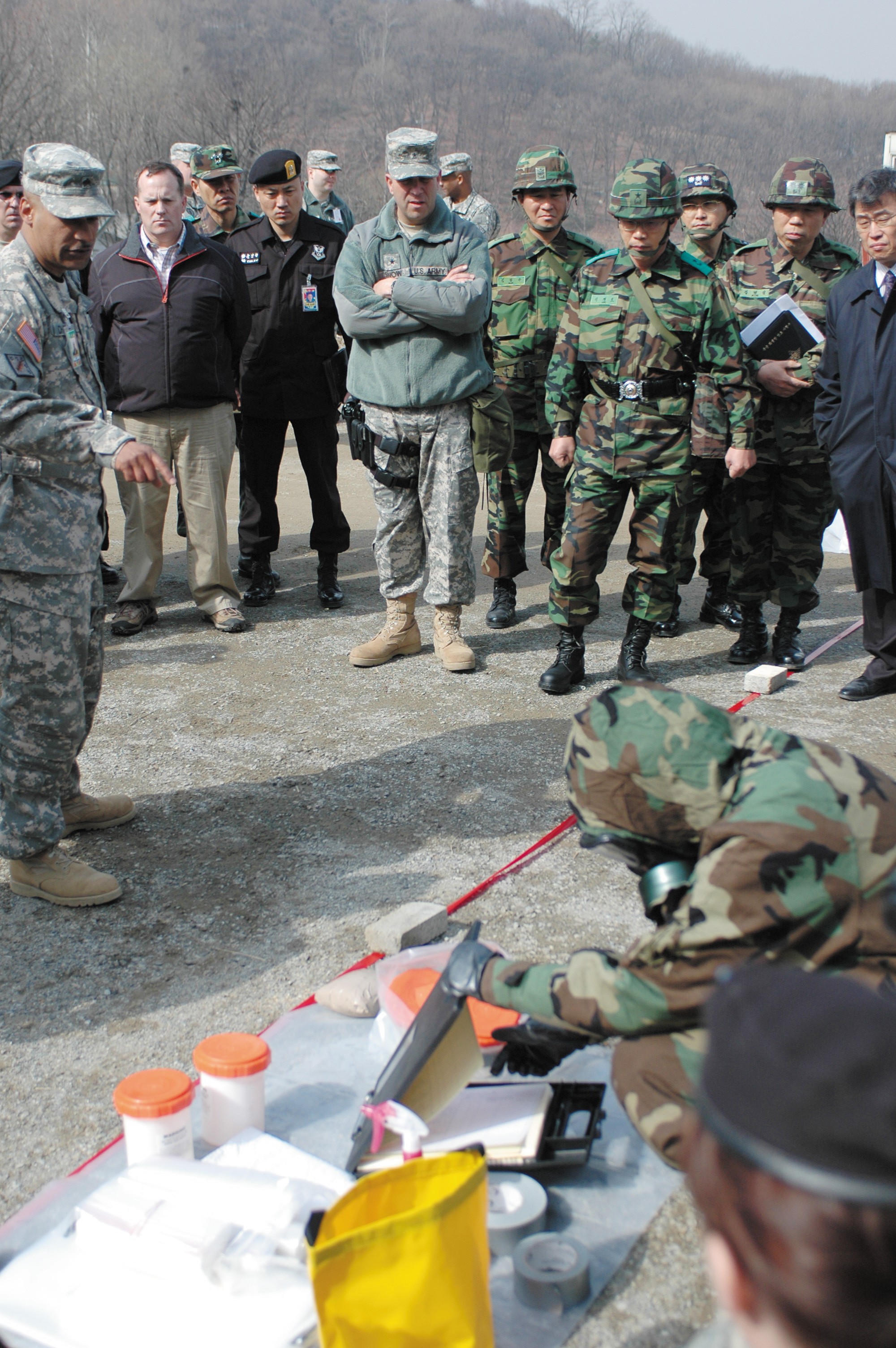
Operation Foal Eagle, the field training exercise associated with Key Resolve 2009 in the Republic of Korea March 14 through 17, was an opportunity for coalition Chemical, Biological, Radiological, Nuclear and high-yield Explosives forces to demonstrate their capabilities during what turned out to be a stressful period for the US-ROK alliance and North Korea.
As North Korea threatened to launch what it claimed was a space satellite, tensions on the peninsula rose. The 1st Area Medical Laboratory, the 110th Chemical Battalion (Technical Escort), the CBRNE Analytical and Remediation Activity, ROK Chemical Special Forces and the ROK Mobile Analysis Laboratory integrated their efforts during the exercise.
They displayed their capabilities to Brig. Gen. Jeffrey J. Snow, Combined Joint Task Force for Elimination commander; Brig. Gen. Jae Ho Lee, ROK Chemical, Biological, Radiological Defense commander; and Brig. Gen. Kwan Heon Lee, ROK Army Chemical School commander, who observed the training exercise March 17.
"This exercise proved to be a great collective training event with our counterparts at the ROK NBC Defense Command, to learn from each other's tactics, techniques and procedures," Snow said.
"It's important that the Republic of Korea understands we are committed to this alliance," Snow added. "This exercise is just one way we can exchange lessons learned and build on our relationship in a productive and collaborative way."
Lt. Col. Ken Pell, executive officer for 1st AML, said the opportunity to work with the ROK Defense Command during Operation Foal Eagle benefitted Soldiers from both countries.
"Our Soldiers were excited to train with their ROK CBRNE counterparts, and the types of questions the ROK CBRNE soldiers were asking shows me how interested they are to learn and how close we are in CBRNE capabilities, especially NBC testing," Pell said.
The 1st AML and CARA are highly specialized in what they do and work predominantly from fixed sites, while the 110th Chemical Battalion (TE) has a variety of CBRNE capabilities that includes its technical escort mission.
"Our purpose is to analyze materials and do a presumptive field analysis," said Sgt. 1st Class Shane Webber, team leader from Company B, 110th Chemical Battalion (TE).
An added benefit of 1st AML and CARA is their technical expertise when they retest the samples to provide a confirmatory analysis to validate the 110th's field analysis, he said.
"The 1st AML and CARA provide that additional lab capability. They have PhDs and doctors who back up the science side of what we do," Webber said.
The influence on the ROK forces was particularly evident in the command structure of the ROK's 24th Chemical Battalion.
The 24th Chemical Battalion has been "converted into a weapons of mass destruction elimination battalion, developed along the lines of our CBRNE Response Teams," Snow said.
Should a conflict break out on the Korean Peninsula, Key Resolve and exercises like Operation Foal Eagle will have been invaluable experiences for the service members and civilians involved. The collaboration and working relationships established during this training could be significant in combined missions on the battlefield, suggested several participants.
"In the future, if war rises up with North Korea, we will ask the United States to please help us," said 1st Lt. Sarang Lee, a biological analyst with the Mobile Analyses Laboratory.
Lee said one major difference he saw during the exercise was the difference in priorities. ROK CBRNE soldiers concentrate on speedy results and U.S. Soldiers apply more of a deliberate process.
"Our objective of analysis is speed, it's very important to analyze the agents as fast as we can," Lee added.
Lee noted a procedural difference in how the United States obtains a sample.
"Their [U.S.] laboratories are running very systematically, such as the chain of custody, we don't have that systematic factor right now," Lee said.
"It's to make sure from the first person who's ever touched it all of the way to the last lab tech who's touched it has accountability of the products," Webber said.
The U.S. forces impose several administrative steps to ensure the chain of custody. When this is applied with the forensic capabilities of other units in and outside of the CJTF-E, valuable intelligence can be gathered that may reveal the extent and capabilities of an enemy WMD program, lead to the discovery of other WMD sites or to the arrest of scientists or others involved in the building of illegal weapons.
This was the second combined exercise on the Korean Peninsula for the CJTF-E and considerable progress is being made. That progress can be seen when the U.S. and ROK CBRNE forces train together.
"Operation Foal Eagle provides us with a means of evaluating our progress as a combined task force," said Snow, "and based on conversations with my ROK counterparts and what I've seen here during the exercise, this training has been an invaluable experience for both sides, and I am looking forward to continuing this relationship in the coming years."

Social Sharing